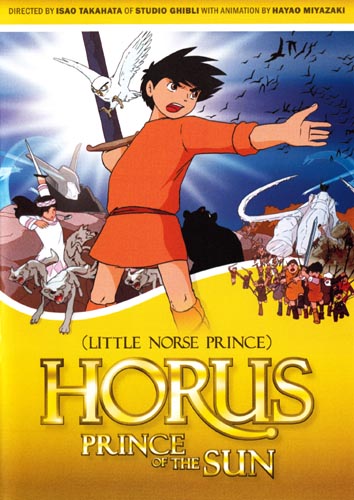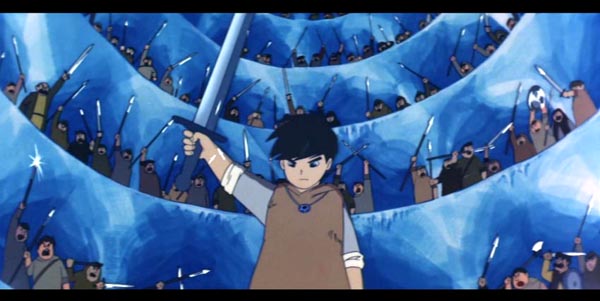landscape and a wordless fight between a boy and a pack of wolves; no
soundtrack, no dialogue, upright panting and grunts and the whistle of a thrown
hatchet whirling around on its thong, knocking wolves for a loop, an
orchestrated portion of determined, synchronized violence that instantly tells the
target audience they aren’t in fairytale land. This land belongs to the Prince
Of the Sun, Horus.
near everybody who ever made a Japanese comic strip you cherished, it’s also a prehistorical
bustle-memory flashback from a time when civilization
modified into nothing better than scattered villages of hunter-gatherers, iron the wonder
technology of the age, and agriculture the disruptive recent startup; when the
forces of nature itself are the enemies mankind should unite and overcome. This is a movie about killing frosty climate and
bringing wait on spring, and if that’s no longer something we can all bring collectively within the wait on of
(severely after closing frosty climate!) I don’t know what’s.
what would make Japanese animation a world phenomenon, provocative past storybooks
and toy commercials to modified into appealing, boundary-pushing motion footage striving in opposition to the
medium’s stereotypes. Most of what
made Japanese animation tops for the next forty years – the yodelly pleasures
of Heidi and a form of World Masterpieces, the dashing Lupin
Oscar-winning ticket that Ghibli would modified into, and a raft of Pokemon designers
and colossal robot animators and Rocky Chuck supervisors –all of them passed through
the peep of Horus.
 The on-veil drama mirrored the within the wait on of-the-scenes
The on-veil drama mirrored the within the wait on of-the-scenesstruggles of Toei animators battling their very own studio, which would bury the
achieved product after ultimate ten days within the cinema. Rescued from obscurity by a generation of
devoted fans, the film would attain a global target audience practically despite its
parent company. And now, after a protracted time of scratchy prints and pan &
scan dubs, Horus is indirectly a legit North American
release in a bundle that gifts an unimaginable movie in tandem with enlightening
amounts of context and background.
But wait on to 1000 BC. Our brave hatchet-boy Horus – we’re
intellectual sure what the screenwriters and the assert actors had been going for modified into “Hols”,
nonetheless “Horus” is what Toei needs to speed with, so “Horus” it is – Horus here is the
Mk 1 version of the Anime Boy Hero we’ll later survey piloting huge robots,
rescuing girls from flying castles, and surviving each and each tsunamis and industrial
fascist plots with a solid ideal arm and a gleam in his peep. His fight with the wolves is interrupted
by the film’s entertaining left modified into yarn; the awakening of the rock huge
Maug, from whose rocky shoulder Horus pulls a rusty nonetheless spectacular sword,
Aesop’s Fables style. Reforged, sharpened, and wielded properly, Maug tells
Horus this sword will make him the Prince Of The Sun. Cue title.
The next ninety minutes bring the overall, unchanging panoply of human
trip; tragedy, need, friendship, deceit, betrayal, bravery, be apologetic about,
heartbreak, perseverance, vengeance, fellowship. An orphaned Horus sets flee to
leave his solitary life and enter the arena his father abandoned; to battle the
frosty climate elemental Grunwald himself with his axe and, if he can reforge it, the
Sword. Alongside the manner he’ll fight wolves,
rats, and an grand monster pike, confront trickery and self-doubt, and be taught
that ultimate the ability of a total community can allow mankind to outlive the
ingredients and in all chance enact an exhaustingly fearless enchanting film.
in ruins, the cursed Hilda and her gentle songs distract the village and
help the venal capabilities of the egg-stealing Drago, who has the ear of the
susceptible-willed headman. Will the village continue to exist bearing the overall force of the
Grunwald’s divide-and-overcome are trying to abolish humanity? His rats are coming;
his wolves are already here. Crippled by her wretchedness and cursed by her dismay, Hilda
fights her own inner battle; and her scornful statement to Horus, trapped in
his own forest of doubt, may well well well as a replacement the predominant that frees them all. We be taught
through fight and hearth that working collectively, males can fight monsters, and that even the damned can bring collectively humanity
through acts of mercy. The film climaxes
with an astounding sequence sharp ice mastodons, flaming towers, and the
white-sizzling reforged Sword Of The Sun sliding onto the ice, ready for Horus, hovering
skyward on a ghost-wolf to enact battle with the Grunwald himself, a stirring
moment of cinema that can well well well upright transcend culture, language, condo and time
itself.
A sprawling, fearless work, Horus is nothing no longer up to a
masterpiece. Pop anthropology aside, the film is a artistic triumph; nonetheless
cinematic victory would issue Pyrrhic. Visually, Horus remodeled Japan’s
animation honest, provocative from the 50s superflat industrial-art form of
earlier Yasuji Mori/ Yoichi Kotabe joints savor Gulliver’s Dwelling Bolt or
Miniature Prince & The Eight Headed
Dragon, against the extra naturalistic, expressive characters we’d survey in every single place
later. Outmoded comic strip childhood and speaking animal chums mingle with
tough-hewn warriors and rock males whereas the Grunwald’s easier attach marks him
as heir to Disney’s “Evening On Bald Mountain”. Horus aspects technical callbacks to motion footage as
disparate as Walt’s Pinocchio and Grimault’s The King And The Mockingbird,
and likewise displays earlier Toei works collectively with the offbeat Jack & The Witch, as loners with ultimate animals for chums are intrigued & betrayed by
girls in thrall to spoiled powers, finding themselves trapped in uncommon
psychoanalytical dimensions.
The screenplay for Horus modified into taken from Kazuo Fukazawa’s
puppet play “Chikisani No Taiyo”, in turn based totally on “Okikurumi To Akuma No Ko”,
a tune-poem yarn from the Yukar, the oral custom of the vanishing Ainu peoples of Hokkaido. This deep-gash ethnicity may well well well be blurred and vaguely
Nordicized for a likely worldwide target audience. Admittedly, the culture of Horus will be of any early Iron Age village within spitting distance of the
Circle
with desolate, practically post-apocalyptic vistas and abandoned, overgrown
settlements. Nonetheless, echoes of the Ainu would be viewed in quite a bit of locations within the
film, severely in Hilda’s costume attach. The film’s underlying themes of
power through team spirit are universal passable, and laid over practically primal myths
of seasonal commerce and rebirth, Horus turns into a yarn as old as man itself.
Manufacturing of Horus started in tumble of 1965, marched past
closing dates and payment overruns, and indirectly wrapped in spring of ’68. In the
intervening time, Toei achieved two Cyborg 009 motion footage, Jack & The Witch, and a Hans
Christian Andersen film. Clearly Miniature Norse Prince modified into a fractious beast, driven onerous by a
sure crew spearheaded by future Oscar nominee Isao Takahata. Toei, ambitiously
striving to be the Walt Disney of the Orient, would match The Mouse in each and each
animation and labor disputes, having survived one spherical of strikes in ’61. More
unrest would discover. Hayao Miyazaki (Poli Sci, Gakushuin University, ’63) after
working no longer up to a year at Toei, modified into already Chief Secretary of Toei Doga’s
labor union, and he, union vice-chair Takahata, and director Yasuo Otsuka
pledged to take so long as a truly powerful to total Horus, which they feared to be
the closing gasp of actual film animation in Japan. Labor and management struggled
to come to phrases in a leisurely 60s atmosphere of insurgent and confrontation, as
Toei proposed replacing salaried veterans with a workers of contract freelancers
– a traipse rejected on the time, nonetheless now practically universal. Horus modified into
greenlit with a 100 million yen finances, negotiated upwards from 70, at a time
when most enchanting motion footage ran fifty to 80. The fearless, uncompromising plans
of newbie director Takahata and his conclude-knit workers added 30 million yen and
two years to the film’s completion. Animation director Yasuo Otsuka would later
ingredient the manufacturing in his memoir, luridly titled “Cels Covered In Sweat.”
 |
| let us vigorously confront the fight of collective action within the worker’s paradise |
Takahata paid for the labor disputes, the tag, and the leisurely offer of Horus with
a demotion from the feature film department. He,
Toei totally in ’71, nonetheless Toei’s loss modified into the animation world’s attach. The key collaborative crew for
Horus modified into an all-huge title anime crew, collectively with first-time route by Isao “Grave
Of The Fireflies” Takahata, Yasuo “Puss
In Boots” Otsuka as animation director, key animation by some
man named Hayao Miyazaki and Yasuji “Future Boy Conan” Mori, Reiko “Taro
The Dragon Boy, Belladonna” Okuyama, and Yoichi “30,000
Leagues In Search Of Mom” Kotabe. These grand abilities would
mosey on to device masterpieces for apartments savor Zuiyo Eizo, Nippon Animation,
Top Craft, and at closing Ghibli.
by the collectivist educated-labor subtext of Horus? Weirded out by the scene where
Horus flies around Grunwald on a ghost wolf whereas an grand rock-man battles an
ice elephant? Who is conscious of. All we know is after Toei buried Horus with a mere
10-day theatrical release, the movie achieved certifiable cult situation, living
on within the hearts of nascent otaku who’d champion it for future years in
fanzines and magazine articles.
Internationally the film modified into a slack starter, hampered by Toei’s respectable
disinterest and advanced insistence in giving the film the English title “Miniature
Norse Prince Daring”, which conflates this film with the Hal Foster Arthurian-fable
comedian strip. American World would license the film for American
tv in 1971, titled “Miniature Norse Prince”. The Fred Ladd-directed dub aspects an
all-huge title 60s anime solid collectively with Billie Lou “Kimba” Watt, Corinne “Trixie” Orr,
Gilbert “Superbook” Mack, and Ray “Gigantor” Owens.
 |
| Italian DVD duvet art. |
American fans made enact with off-air copies of the
pan & scan tv print unless a Japan-ultimate LD release in 1995. British
media agency Optimum released a R2
film in 2010, with English subs ultimate. In inequity, Discotek’s present Horus DVD release is all-inclusive and basically critical. The print is flawless and
contains the recent Japanese soundtrack and the
dub. Special aspects abound; Mike“Anime Soar” Toole’s commentary contains sharp small print referring to the Disney-savor ambitions
of Hiroshi Okawa and a sizable fable of the time
“the Citizen Kane of anime.” There’s footage of a inviting French TV interview
with Takahata from 1995, a manufacturing art gallery, the recent Japanese
trailer, a Yoichi Kotabe interview detailing their actual-life examine, and a
slideshow feature demonstrating each and each the foundation Horus took from earlier
motion footage and later works that is in all chance influenced by Horus. The helpful Benjamin Ettinger delivers an essay about Reiko Okuyama, pioneering female Horus key animator
who key-enchanting her husband’s directorial debut, Flying Phantom Ship.
own Horus, Prince Of The Sun, and I disclose that without reservation or
qualification. The reason we’re even staring at Japanese animation on this facet
of the Pacific is its ability to transcend national borders and to communicate to
of us on a frequent human level, and Horus is one of many most productive examples of the medium’s
universal enchantment. Japanese animation of this traditional isn’t usually awarded this
level of respect here in
past mere fandom and even the enchantment of animation in frequent, Horus succeeds
as a piece of cinema that needs to be famend by all who like film for its
own sake. Toei would never again be as fearless because it modified into with Horus, Prince Of The
Sun, and even a protracted time later, the sweat and fight of Takahata, Otsuka,
us all.








